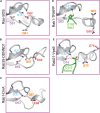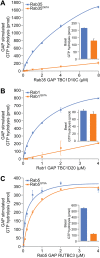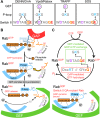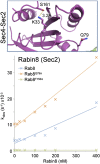Diversity and plasticity in Rab GTPase nucleotide release mechanism has consequences for Rab activation and inactivation
- PMID: 24520163
- PMCID: PMC3919270
- DOI: 10.7554/eLife.01623
Diversity and plasticity in Rab GTPase nucleotide release mechanism has consequences for Rab activation and inactivation
Abstract
Ras superfamily GTPase activation and inactivation occur by canonical nucleotide exchange and GTP hydrolysis mechanisms. Despite conservation of active-site residues, the Ras-related Rab GTPase activation pathway differs from Ras and between different Rabs. Analysis of DENND1-Rab35, Rabex-Rab5, TRAPP-Rab1 and DrrA-Rab1 suggests Rabs have the potential for activation by distinct GDP-release pathways. Conserved active-site residues in the Rab switch II region stabilising the nucleotide-free form differentiate these pathways. For DENND1-Rab35 and DrrA-Rab1 the Rab active-site glutamine, often mutated to create constitutively active forms, is involved in GEF mediated GDP-release. By contrast, in Rab5 the switch II aspartate is required for Rabex mediated GDP-release. Furthermore, Rab1 switch II glutamine mutants refractory to activation by DrrA can be activated by TRAPP, showing that a single Rab can be activated by more than one mechanistically distinct GDP-release pathway. These findings highlight plasticity in the activation mechanisms of closely related Rab GTPases. DOI: http://dx.doi.org/10.7554/eLife.01623.001.
Keywords: Rab GTPase; membrane traffic; nucleotide exchange factor.
Conflict of interest statement
The authors declare that no competing interests exist.
Figures






Comment in
-
Mutant enzymes challenge all assumptions.Elife. 2014 Feb 11;3:e02171. doi: 10.7554/eLife.02171. Elife. 2014. PMID: 24520166 Free PMC article.
Similar articles
-
Structural plasticity mediates distinct GAP-dependent GTP hydrolysis mechanisms in Rab33 and Rab5.FEBS J. 2017 Dec;284(24):4358-4375. doi: 10.1111/febs.14314. Epub 2017 Nov 23. FEBS J. 2017. PMID: 29095572
-
Structural insights into the dual nucleotide exchange and GDI displacement activity of SidM/DrrA.EMBO J. 2010 Jan 20;29(2):496-504. doi: 10.1038/emboj.2009.347. Epub 2009 Nov 26. EMBO J. 2010. PMID: 19942850 Free PMC article.
-
Insights regarding guanine nucleotide exchange from the structure of a DENN-domain protein complexed with its Rab GTPase substrate.Proc Natl Acad Sci U S A. 2011 Nov 15;108(46):18672-7. doi: 10.1073/pnas.1110415108. Epub 2011 Nov 7. Proc Natl Acad Sci U S A. 2011. PMID: 22065758 Free PMC article.
-
The TRAPP complexes: oligomeric exchange factors that activate the small GTPases Rab1 and Rab11.FEBS Lett. 2023 Mar;597(6):734-749. doi: 10.1002/1873-3468.14553. Epub 2022 Dec 18. FEBS Lett. 2023. PMID: 36477798 Free PMC article. Review.
-
The TRAPP complexes: discriminating GTPases in context.FEBS Lett. 2023 Mar;597(6):721-733. doi: 10.1002/1873-3468.14557. Epub 2022 Dec 21. FEBS Lett. 2023. PMID: 36481981 Free PMC article. Review.
Cited by
-
Structural and Biophysical Characterization of Rab5a from Leishmania Donovani.Biophys J. 2018 Oct 2;115(7):1217-1230. doi: 10.1016/j.bpj.2018.08.032. Epub 2018 Aug 30. Biophys J. 2018. PMID: 30241678 Free PMC article.
-
Stochastic activation and bistability in a Rab GTPase regulatory network.Proc Natl Acad Sci U S A. 2020 Mar 24;117(12):6540-6549. doi: 10.1073/pnas.1921027117. Epub 2020 Mar 11. Proc Natl Acad Sci U S A. 2020. PMID: 32161136 Free PMC article.
-
Mutant enzymes challenge all assumptions.Elife. 2014 Feb 11;3:e02171. doi: 10.7554/eLife.02171. Elife. 2014. PMID: 24520166 Free PMC article.
-
Architecture and mechanism of the late endosomal Rab7-like Ypt7 guanine nucleotide exchange factor complex Mon1-Ccz1.Nat Commun. 2017 Jan 4;8:14034. doi: 10.1038/ncomms14034. Nat Commun. 2017. PMID: 28051187 Free PMC article.
-
TRAPPII regulates exocytic Golgi exit by mediating nucleotide exchange on the Ypt31 ortholog RabERAB11.Proc Natl Acad Sci U S A. 2015 Apr 7;112(14):4346-51. doi: 10.1073/pnas.1419168112. Epub 2015 Mar 23. Proc Natl Acad Sci U S A. 2015. PMID: 25831508 Free PMC article.
References
Publication types
MeSH terms
Substances
Grants and funding
LinkOut - more resources
Full Text Sources
Other Literature Sources
Molecular Biology Databases

